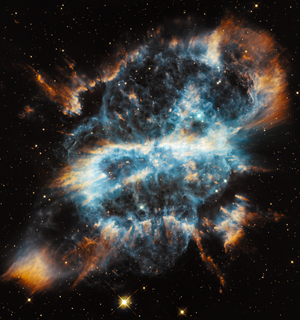NGC 5189
| Emission nebula | |
|---|---|
| Planetary nebula | |
 NGC 5189 image taken with the Hubble Space Telescope on July 6, 2012 | |
| Observation data: J2000.0 epoch | |
| Right ascension | 13h 33m 32.97s |
| Declination | −65° 58′ 26.7″ |
| Distance | 3000 ly |
| Apparent magnitude (V) | 8.2, 8.5p |
| Apparent dimensions (V) | 90 × 62 arcsec |
| Constellation | Musca |
| Physical characteristics | |
| Radius | ~1 ly |
| Absolute magnitude (V) | - |
| Notable features | A peculiar PN with a binary in the center |
| Designations | Spiral Planetary Nebula, Gum 47, IC 4274, He2-94, Sa2-95, PK 307-3.1 |
NGC 5189 (Gum 47, IC 4274, nicknamed Spiral Planetary Nebula) is a planetary nebula in the constellation Musca. It was discovered by James Dunlop on 1 July 1826, who catalogued it as Δ252.[1] For many years, well into the 1960s, it was thought to be a bright emission nebula. It was Karl Gordon Henize in 1967 who first described NGC 5189 as quasi-planetary based on its spectral emissions.
Seen through the telescope it seems to have an S shape, reminiscent of a barred spiral galaxy. The S shape, together with point-symmetric knots in the nebula, have for a long time hinted to astronomers that a binary central star is present.[2] The Hubble Space Telescope imaging analysis showed that this S shape structure is indeed two dense low-ionization regions: one moving toward the north-east and another one moving toward the south-west of the nebula,[3] which could be a result of a recent outburst from the central star. Observations with the Southern African Large Telescope have finally found a white dwarf companion in a 4.04 day orbit around the rare low-mass Wolf-Rayet type central star of NGC 5189.[4] NGC 5189 is estimated to be 546 parsecs[5] or 1,780 light years away from Earth. Other measurements have yielded results up to 900 parsecs (~3000 light-years).[6]
References
[edit]- ^ "NGC 5189 (Mus)". Southern Astronomical Delights. Archived from the original on 14 January 2014.
- ^ Phillips, J. P.; Reay, N. K. (1983). "Ansae and the precession of central stars in planetary nebulae - The cases of NGC 5189 and NGC 6826". Astronomy and Astrophysics. 117: 33–37. Bibcode:1983A&A...117...33P.
- ^ Danehkar, Ashkbiz; Karovska, Margarita; Maksym, W. Peter; Montez, Rodolfo (January 2018). "Mapping Excitation in the Inner Regions of the Planetary Nebula NGC 5189 Using HST WFC3 Imaging". The Astrophysical Journal. 852 (2): 87. arXiv:1711.11111. Bibcode:2018ApJ...852...87D. doi:10.3847/1538-4357/aa9e8c. ISSN 0004-637X. S2CID 119365610.
- ^ Manick, Rajeev; Miszalski, Brent; McBride, Vanessa (1 April 2015). "A radial velocity survey for post-common-envelope Wolf–Rayet central stars of planetary nebulae: first results and discovery of the close binary nucleus of NGC 5189★". Monthly Notices of the Royal Astronomical Society. 448 (2): 1789–1806. arXiv:1501.03373. Bibcode:2015MNRAS.448.1789M. doi:10.1093/mnras/stv074. ISSN 1365-2966. S2CID 118600965.
- ^ "NGC 5189". SIMBAD. Centre de données astronomiques de Strasbourg. Retrieved 21 December 2012.
- ^ Sabin, L.; Vázquez, R.; López, J. A.; García-Díaz, Ma. T.; et al. (2012). "The filamentary Multi-Polar Planetary Nebula NGC 5189" (PDF). Revista Mexicana de Astronomía y Astrofísica. 48: 165–76. arXiv:1203.1297. Bibcode:2012RMxAA..48..165S.
External links
[edit] Media related to NGC 5189 at Wikimedia Commons
Media related to NGC 5189 at Wikimedia Commons- NGC 5189 on WikiSky: DSS2, SDSS, GALEX, IRAS, Hydrogen α, X-Ray, Astrophoto, Sky Map, Articles and images
- NASA Astronomy Picture of the Day: NGC 5189: A Strange Planetary Nebula (11 December 1995)
- NASA Astronomy Picture of the Day: NGC 5189: An Unusually Complex Planetary Nebula (19 December 2012)
- A Cosmic Holiday Ornament, Hubble-Style
- Southern African Large Telescope: Elusive Binary System
